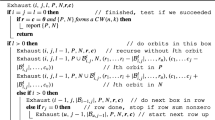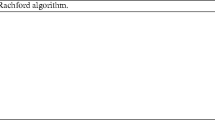Abstract
In this paper, we demonstrate that the search for weighing matrices constructed from two circulants can be viewed as a minimization problem together with two competent genetic algorithms to locate optima of an objective function. The motivation to deal with the messy genetic algorithm (mGA) is given from the pioneering results of Goldberg, regarding the ability of the mGA to put tight genes together in a solution which points directly to structural patterns in weighing matrices. In order to take into advantage certain properties of two ternary sequences with zero autocorrelation we use an adaptation of the fast messy GA (fmGA) where we combine mGA with advanced techniques, such as thresholding and tie-breaking. This transformation of the weighing matrices problem to an instance of a combinatorial optimization problem seems to be promising, since we resolved two open cases for weighing matrices as these are listed in the second edition of the Handbook of Combinatorial Designs.
Similar content being viewed by others
References
Arasu KT, Gulliver TA (2001) Self-dual codes over \(\mathbb{F}_{p}\) and weighing matrices. IEEE Trans Inf Theory 47:2051–2055
Bean JC (1994) Genetic algorithms and random keys for sequencing and optimization. ORSA J Comput 6:154–160
Chen Y-p, Yu T-L, Sastry K, Goldberg DE (2007) A survey of linkage learning techniques in genetic and evolutionary algorithms. IlliGAL report No 2007014, University of Illinois at Urbana-Champaign, Urbana IL
Craigen R, Kharaghani H (2007) Orthogonal designs. In: Colbourn CJ, Dinitz JH (eds) Handbook of combinatorial designs. Discrete mathematics and its applications, 2nd edn. Chapman & Hall/CRC, Boca Raton, pp 280–295
Craigen R, Gibson W, Georgiou S, Koukouvinos C (2006) Further explorations into ternary complementary pairs. J Comb Theory, Ser A 113:952–965
van Dam W (2002) Quantum algorithms for weighing matrices and quadratic residues. Algorithmica 34:413–428
Day RO, Lamont GB (2005) Extended multi-objective fast messy genetic algorithm solving deception problems. In: Evolutionary multi-criterion optimization in proceedings of third international conference. Lecture notes in computer science, vol 3410, pp 296–310
Geramita AV, Seberry J (1979) Orthogonal designs. Quadratic forms and Hadamard matrices. Lecture notes in pure and applied mathematics, vol 45. Dekker, New York
Goncalves JF, Resende MGC (to appear) Biased random-key genetic algorithms for combinatorial optimization. J Heuristics. doi:10.1007/s10732-010-9143-1
Goldberg DE (1987) Simple genetic algorithms and the minimal deceptive problem. In: Davis L (ed) Genetics algorithms and simulated annealing. Pitman, London, pp 74–88
Goldberg DE (1989) Genetic algorithms in search, optimization, and machine learning. Addison-Wesley, Reading
Goldberg DE, Deb K, Korb B (1989) Messy genetic algorithms: motivation, analysis, and first results. Complex Syst 3(5):493–530
Goldberg DE, Deb K, Korb B (1990) Messy genetic algorithms revisited: studies in mixed size and scale. Complex Syst 4(4):415–444
Goldberg DE, Deb K, Kargupta H, Harik G (1993) Rapid, accurate optimization of difficult problems using fast messy genetic algorithms. In: Proceedings of the fifth international conference on genetic algorithms
Goldberg DE, Deb K, Thierens D (1993) Towards a better understanding of mixing in genetic algorithms. J Soc Instrum Control Eng 32:10–16
Harik GR, Goldberg DE (1996) Learning linkage. In: Foundations of genetic algorithms, vol 4. Morgan Kaufmann, San Mateo, pp 247–262
Hotelling H (1944) Some improvements in weighing and other experimental techniques. Ann Math Stat 16:294–300
Knjazew D (2002) OmeGA: a competent genetic algorithm for solving permutation and scheduling problems. Kluwer, Norwell
Kotsireas I, Koukouvinos C, Seberry J (2009) Weighing matrices and string sorting. Ann Comb 13:305–313
Kotsireas I, Koukouvinos C, Pardalos P (2010) An efficient string sorting algorithm for weighing matrices of small weight. Optim Lett 4(1):29–36
Kotsireas I, Koukouvinos C, Pardalos P (to appear) A modified power spectral density test applied to weighing matrices with small weight. J Comb Optim. doi:10.1007/s10878-010-9335-5
Kotsireas I, Koukouvinos C, Pardalos P, Shylo O (2010) Periodic complementary binary sequences and combinatorial optimization algorithms. J Comb Optim 20:63–75
Kotsireas IS, Koukouvinos C, Seberry J, Simos DE (2010) New classes of orthogonal designs constructed from complementary sequences with given spread. Aust J Comb 46:67–78
Koukouvinos C (1996) Sequences with zero autocorrelation. In: Colbourn CJ, Dinitz JH (eds) The CRC handbook of combinatorial designs. CRC Press, Boca Raton, pp 452–456
Koukouvinos C, Seberry J (1997) Weighing matrices and their applications. J Stat Plan Inference 62(1):91–101
Koukouvinos C, Seberry J (1999) New weighing matrices and orthogonal designs constructed using two sequences with zero autocorrelation function—a review. J Stat Plan Inference 81(1):153–182
Pardalos PM, Du D-Z (1998) Handbook of combinatorial optimization. Combinatorial optimization, vol 2. Kluwer Academic/Springer, Norwell/Dordrecht
Pardalos PM, Resende MGC (eds) (2002) Handbook of applied optimization. Oxford University Press, New York
Raghavarao D (1971) Constructions and combinatorial problems in design of experiments. Wiley series in probability and statistics. Wiley, New York
Rothlauf F (2006) Representations for genetic and evolutionary algorithms, 2nd edn. Physica-Verlag, Heidelberg
Seberry J, Yamada M (1992) Hadamard matrices, sequences and block designs. In: Dinitz JH, Stinson DR (eds) Contemporary design theory: a collection of surveys. Wiley, New York, pp 431–560
Winter PC, Hickey GI, Fletcher HL (2006) Instant notes in genetics, 3rd edn. Springer/BIOS Scientific Publishers/Taylor & Francis, New York/Oxford/London
Author information
Authors and Affiliations
Corresponding author
Rights and permissions
About this article
Cite this article
Kotsireas, I.S., Koukouvinos, C., Pardalos, P.M. et al. Competent genetic algorithms for weighing matrices. J Comb Optim 24, 508–525 (2012). https://doi.org/10.1007/s10878-011-9404-4
Published:
Issue Date:
DOI: https://doi.org/10.1007/s10878-011-9404-4




